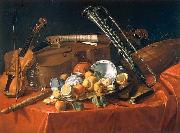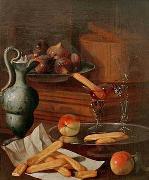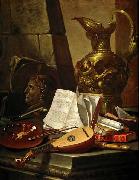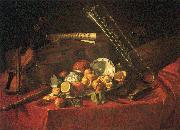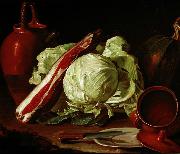Cristoforo Munari Oil Painting ReproductionAll Cristoforo Munari Oil Paintings(July 21, 1667 - June 3, 1720) was an Italian painter of the late-Baroque specializing in still life paintings. He was also known as Cristofano Monari. His initial training was in Reggio Emilia, his birthplace, and he came under the patronage of Rinaldo d'Este, Duke of Modena. In 1703-1706, he lived in Rome, then moved to Florence, where for about a decade he was attached to the court of the Medici. His still life paintings recall those of Evaristo Baschenis; however, the added disarray of porcelain, glass, and foodstuffs, suggest the hangover from the jovial surfeit of the Medici court. He painted also panoplies and war trophies. In 1715 he moved to Pisa where he worked almost exclusively in art restoration; he died in 1720. An exhibition of his paintings took place in 1998 in Reggio Emilia, where it attracted wide attention and was a national success. |
|||

|
|||
|
|
|||
|
||||||||
| Cristoforo Munari (July 21, 1667 - June 3, 1720) was an Italian painter of the late-Baroque specializing in still life paintings. He was also known as Cristofano Monari. His initial training was in Reggio Emilia, his birthplace, and he came under the patronage of Rinaldo d'Este, Duke of Modena. In 1703-1706, he lived in Rome, then moved to Florence, where for about a decade he was attached to the court of the Medici. His still life paintings recall those of Evaristo Baschenis; however, the added disarray of porcelain, glass, and foodstuffs, suggest the hangover from the jovial surfeit of the Medici court. He painted also panoplies and war trophies. In 1715 he moved to Pisa where he worked almost exclusively in art restoration; he died in 1720. An exhibition of his paintings took place in 1998 in Reggio Emilia, where it attracted wide attention and was a national success. |
||||||||
|
|
||||||||
| Gemälde IDENTIFIZIERUNG:: 74467 Stilleben mit Musikinstrumenten und Fruchten c. 1706-03 Oil on canvas cjr |
||||||||
|
|
||||||||
| Gemälde IDENTIFIZIERUNG:: 74478 Eisbehalter, Majolikakanne, Glaser und Loffelbiskuits c. 1714 Oil on canvas 70,5 x 58,5 cm cjr |
||||||||
|
|
||||||||
| Gemälde IDENTIFIZIERUNG:: 74657 Allegoria delle arti Oil on canvas 117 X 92 cm (46.06 X 36.22 in) cjr |
||||||||
|
|
||||||||
| Gemälde IDENTIFIZIERUNG:: 74681 Still-Life with Musical Instruments 1706-15 Oil on canvas |
||||||||
|
|
||||||||
| Gemälde IDENTIFIZIERUNG:: 74766 Vasellame di terracotta, zucca, verza, spalla di maiale e piatto con coltello Piatti, vasellame di coccio e di peltro, bistecca e galli Vasellame di terracotta, zucca, verza, spalla di maiale e piatto con coltello Piatti, vasellame di coccio e di peltro, bistecca e galli. Oil on canvas 73.0 X 87.0 cm cjr |
||||||||
|
|
||||||||
| VORHERIGER KÜNSTLER NÄCHSTER KÜNSTLER | ||||||||
|
|
||||||||
|
Cristoforo Munari (July 21, 1667 - June 3, 1720) was an Italian painter of the late-Baroque specializing in still life paintings. He was also known as Cristofano Monari. His initial training was in Reggio Emilia, his birthplace, and he came under the patronage of Rinaldo d'Este, Duke of Modena. In 1703-1706, he lived in Rome, then moved to Florence, where for about a decade he was attached to the court of the Medici. His still life paintings recall those of Evaristo Baschenis; however, the added disarray of porcelain, glass, and foodstuffs, suggest the hangover from the jovial surfeit of the Medici court. He painted also panoplies and war trophies. In 1715 he moved to Pisa where he worked almost exclusively in art restoration; he died in 1720. An exhibition of his paintings took place in 1998 in Reggio Emilia, where it attracted wide attention and was a national success. |
||||||||
|
|
||||||||
|
KONTAKTIEREN Sie UNS |





